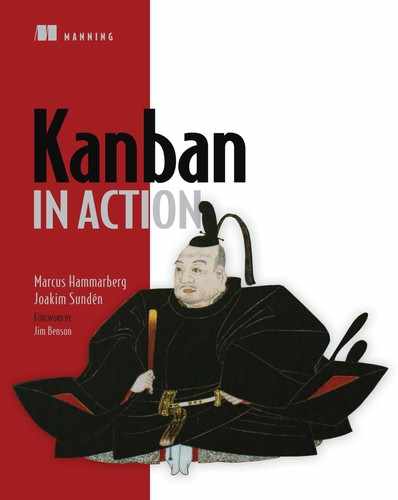Preface
Marcus’s journey
I was introduced to agile via Scrum and started to use it, guerilla-style, at a large insurance company in Sweden. Before long, it spread; and within a few years the company had more than 50 Scrum teams. But it still didn’t feel right, because the work processes for many teams weren’t a good fit with the start-stop nature of Scrum. Also, most teams didn’t span the entire process; the teams mostly consisted of developers who were handed requirements and who then delivered to a separate testing phase. I felt the itch to try to incorporate more of the complete process that the work went through.
This itch led me to start investigating other practices in the agile community. Before long, and through some helpful pointers from Joakim, I found and started to read up on kanban. In 2010 and 2011, I attended trainings on kanban and kanban coaching given by David J. Anderson. These further confirmed my feeling that kanban and Lean were what I had been looking for.
Joakim’s journey
In 2008, I was consulting as a Scrum Master in a three-team software development project in a large Swedish company’s IT department. To deepen my understanding of agile software development, I was reading up on Lean software development—which led me to the amazing story of Toyota and a lot of literature about Lean thinking and the Toyota Way. The studying reached a climax of sorts when I went on a study tour to Toyota HQ in Japan together with Mary and Tom Poppendieck, authors of Lean software development books, in the spring of 2009.
In late 2008, my client came to the conclusion that most, if not all, clients paying for software development eventually draw—that things are moving too slowly. They wanted more development done more quickly, but without cutting scope or quality. Inspired by the Lean thinking around one-piece contiguous flow, I suggested that we should stop planning batches of work in Scrum sprint-planning meetings every two or three weeks (a cadence that felt more and more arbitrary to us) and instead try to focus on one or a few work items and collaboratively get them done as quickly as possible, in a continuous flow of value. The dozen or so team members agreed to not have more than two work items in development and two in testing at any time, and that only when something was finished would we pull new work items from the backlog to plan them just-in-time.
I soon learned about something called kanban that seemed similar to what we were doing, first through Corey Ladas’s blog and then through the work of David J. Anderson. In 2009, I connected with the community through the first Lean Kanban conference in the UK. I was immediately attracted by the pragmatic approach of looking at what had actually worked for different teams and companies in their respective contexts, at a time when I felt that a lot of the agile community focus was on faith-based approaches like “How is Scrum telling us how to solve this?”
The next year, I participated in David J. Anderson’s first kanban coaching workshop ever (now called Advanced Master Class) in London, together with, among others, experienced practitioners like Rachel Davies, David P. Joyce, and Martine Devos. I cofounded Stockholm Lean Coffee in 2010, where kanban enthusiasts have kept meeting every week since. In 2011, I was invited to attend the first Kanban Leadership Retreat hosted by David J. Anderson, during which I became one of the first “David J. Anderson approved” kanban trainers.
The common journey
Together with our colleague at Avega Group at the time, Christophe Achouiantz, we started developing a practical introduction to kanban in 2010. It was an immediate success and the starting point for a long series of conference talks in both Europe and the US, including in-client trainings, tutorials, and workshops, sometimes conducted individually, sometimes by the two of us together. The practical approach of our work resonated well with many people who attended our talks and tutorials, and we received a lot of positive feedback.
It was after a conference tutorial at JFokus (a great conference organized by Mattias Karlsson, another Avega Group colleague) that Marcus got a call from Manning Publications, asking him if he was interested in writing a book. He immediately felt that he should do it together with Joakim. We decided to write the book in the same manner as the presentation we had created, using a practical approach and a lighthearted style.
